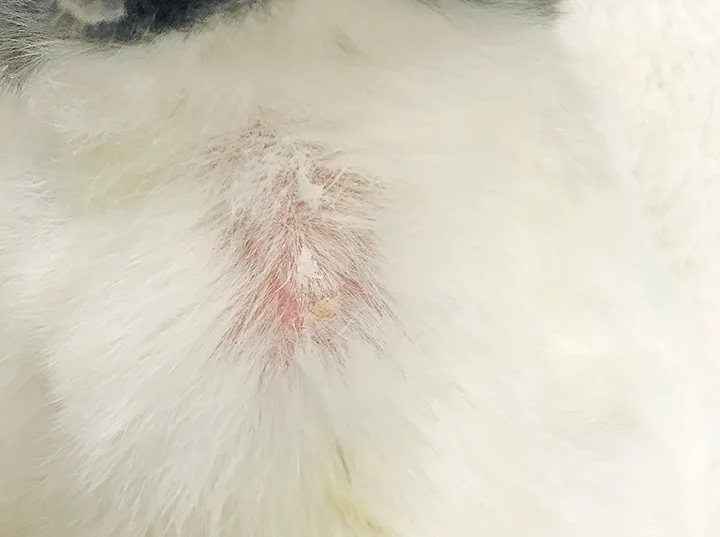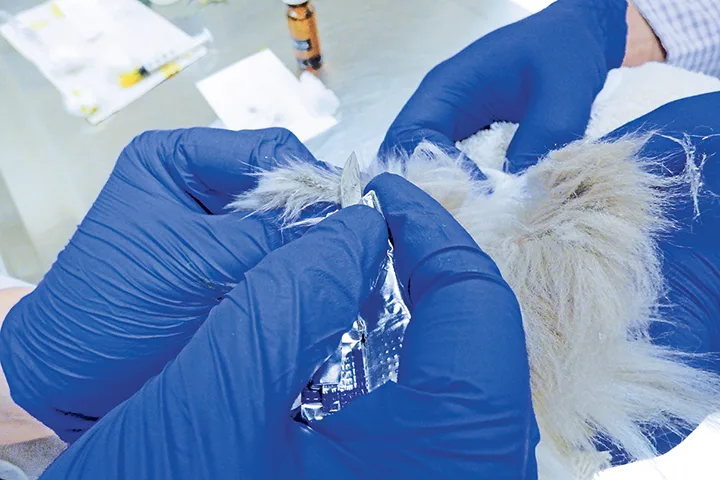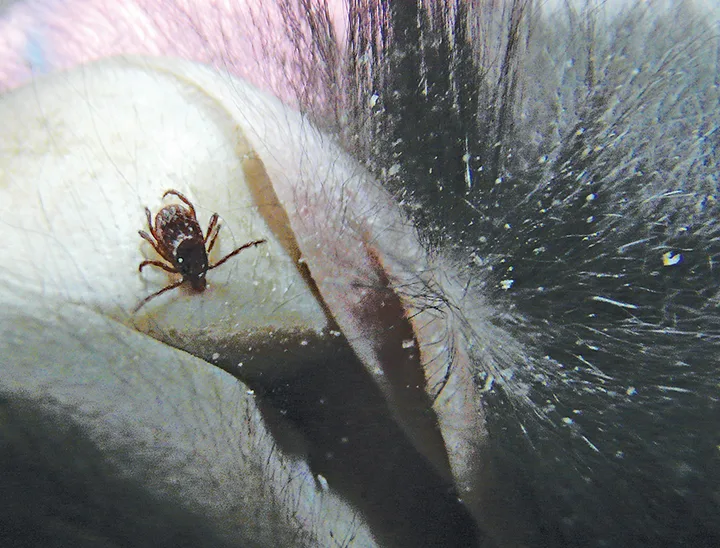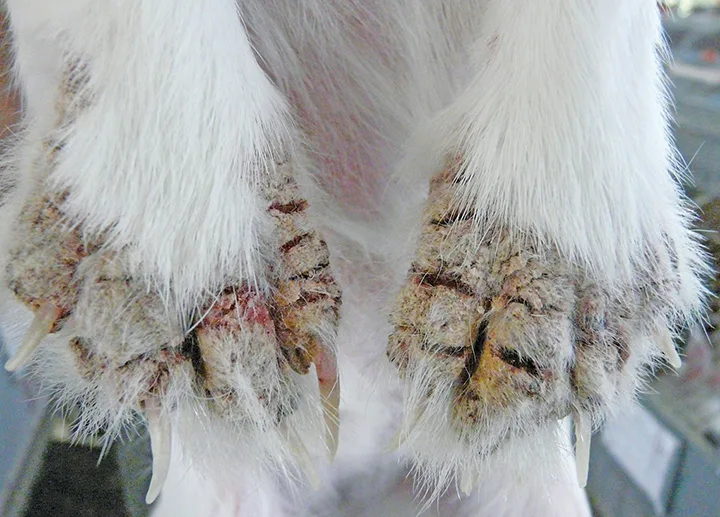Ectoparasites in Rabbits
David Eshar, DVM, DABVP (ECM), DECZM (SM & ZHM), Kansas State University

Dermatologic diseases are among the most common clinical presentations in rabbits (Oryctolagus cuniculus). Most dermatoses in rabbits occur secondary to parasitic infestation.1
Many clinical presentations in rabbits result from suboptimal husbandry (eg, environment, diet)2; therefore, a thorough review of patient husbandry is critical for successful diagnosis and treatment of dermatoses and/or parasitic infestation. The owner should be questioned about the patient’s caging system, substrate, bedding, and diet and whether the patient is indoor, outdoor, or both. More targeted questions pertaining to skin disease (eg, duration of any past diseases, treatment, whether other animals in the household are also showing dermatologic signs) can also be beneficial. Once identified, any husbandry deficiencies should be corrected and the environment treated (eg, cage cleaned, bedding removed, other animals in the household evaluated) to control the parasitic infestation and prevent recurrence.2,3
Clinical Signs
Rabbits infested with ectoparasites can show a variety of clinical signs, most commonly pruritus, scaling or crusting, hair loss, erythema, excoriations, erosions, alopecia, and/or nodules (Figure 1).2-6 Pruritus is the most common clinical sign associated with ectoparasites in rabbits2-4; thus, recognition of pruritus in patients, in other animals in contact with the patient, or in the owner is crucial.

Focal dermal lesions of alopecia and scaling in a rabbit infested with skin mites
Diagnosis
A detailed dermatologic examination is necessary in all rabbits presented with skin disease suspected to be secondary to parasitic infestation. Because rabbits are prone to being fractious, safe restraint is required to obtain quality diagnostic skin samples, and anesthesia or sedation may be indicated in some patients.2-6
Several useful dermatologic diagnostic tests, including impression smears, are available for rabbits. Direct slide impressions are often used in patients with moist, exudative, or crusted lesions. A moistened swab can also be used to collect cytologic samples, which can then be rolled onto a slide. Brushed hair and debris can be useful for detection of superficial ectoparasites (eg, certain mites, lice) and their eggs. Skin scrapings (Figure 2), both superficial (ie, collection of oiled debris) and deep (ie, down to dermal capillary bleeding), can also be useful in the detection of ectoparasites and their eggs. Because rabbits have thin skin, a dulled scalpel blade or a scraping spatula should be used to perform skin scrapings. Bacterial culture and susceptibility testing can be useful for samples collected from any exudative, crusted, nodular, or cystic lesion. A trichogram can be used to evaluate for ectoparasites and dermatophytosis (eg, fungal hyphae, ectothrix) and for broken or fractured hair ends that would help determine whether hair loss is traumatic. Acetate tape impressions are preferred for drier lesions and can be useful in the detection of superficial ectoparasites and their eggs, particularly Cheyletiella spp. Other common diagnostic tests include fungal culture, Wood’s lamp, skin biopsies for histopathology, and clinical pathology testing, including CBC and serum chemistry profile, as some skin lesions may be reflective of systemic disease.

Skin scrape using a dulled #10 scalpel blade to collect hair and skin debris before microscopic examination
Fleas
Pet rabbits may commonly acquire Ctenocephalides spp if in the same household as a carrier dog or cat. Various flea species, including the rabbit flea (Spilopsyllus cuniculi), the common Eastern rabbit flea (Cediopsylla simplex), the giant Eastern rabbit flea (Odontopsyllus multispinosus), and the sticktight flea (Echidnophaga gallinacea), may be found on pet rabbits that are housed outside or that have been exposed to wild rabbits. S cuniculi infestations are common in rabbit colonies.2 The life cycle of this flea is influenced by the hormonal cycle of the host, with sudden proliferation seen in pregnant does and young rabbits. In endemic areas, S cuniculi is a vector for myxomatosis.2 Flea-infested rabbits often are clinically normal, have pruritus, or display a poor coat. Diagnosis is made via flea removal and microscopic identification.
Lice
Infestations by Haemodipsus ventricosus, a sucking louse, are common in wild lagomorphs but rare in pet rabbits (Figure 3). Pruritus, erythema, papules, alopecia, and, rarely, anemia may be present in infested rabbits. Lice may also act as a vector for tularemia (Francisella tularensis).2,6 Diagnosis is made via microscopic visualization of the lice and eggs (ie, nits).2

Lice between parted hair on physical examination of an animal presented for pruritus
Ticks
Many species of ticks feed on rabbits (Figure 4). The most common in North America to feed on rabbits is the continental rabbit tick (Haemaphysalis leporispalustris).2,4,6 Rabbits can serve as hosts for each stage of the continental rabbit tick’s life cycle, although the tick must leave the rabbit after feeding to develop and molt between each stage. Tick infestation can cause anemia, and ticks also serve as vectors for myxomatosis, papillomavirus, and tularemia. Ticks should be physically removed from rabbits.2,4,6 Because of the potential presence of zoonotic pathogens (eg, Rickettsia rickettsii, Francisella tularensis), it is crucial that clinicians ensure proper tick removal with forceps or a tick-removal instrument.

A Rhipicephalus sanguineus tick (ie, brown dog tick) on the medial ear pinna of a rabbit allowed outdoors during mild weather
Mites
The nonburrowing ear mite Psoroptes cuniculi is one of the most common causes of dermatologic disease and a frequent cause of otitis externa in rabbits.6 Typical clinical signs include pruritic otitis with thick crusts on the ear pinna.2,6 Neurologic signs may be exhibited in patients with purulent otitis media and/or tympanum perforation. Other skin involvement may be seen on the face, neck, and/or external genitalia. Mites can be observed through microscopic examination of crusts or skin scrapings.2,4,6
Sarcoptic acariasis from the burrowing mite Sarcoptes scabiei var cuniculi can also occur in pet rabbits4 and results in a highly pruritic, hyperkeratotic dermatosis that often initially affects the skin around the face, feet, and external genitalia (Figure 5).6 This zoonotic ectoparasite can cause an intense papular pruritus often on the limbs and torso of affected humans. Mites can be observed through microscopic examination of superficial and deep skin scrapings.3,4
Cheyletiella parasitovorax, the rabbit fur mite, is a nonburrowing mite that can sometimes be visible to the naked eye as “walking dandruff.” Some rabbits can be subclinical carriers, but patients with heavy infestations may have mild crusting and scaling along the dorsum, variable pruritus, and partial alopecia (Figure 6).2-4,6 This zoonotic mite can cause pruritic papular dermatitis in humans and can also be transferred to other animals in the household.3,7 The mites can be observed on microscopic examination of superficial skin scrapings or cellophane tape samples (Figure 7).2

FIGURE 5
Severe presentation of sarcoptic mange on the feet of an affected rabbit
Leporacarus gibbus is a nonburrowing fur-clasping mite that is usually nonpathogenic but may cause alopecia and scaling.4,6 This zoonotic ectoparasite can cause dermatosis with papular urticaria in humans.7 Mites can be seen on microscopic examination of skin scrapings, trichogram, or acetate tape impression.2
Demodicosis (Demodex cuniculi) in rabbits is often subclinical, and rabbits with dermal lesions (eg, pruritus, crusting) are often affected by other systemic illnesses. Diagnosis is made via microscopic examination of deep skin scrapings and trichogram.2 Infestation by the mite Ornithonyssus bacoti is common in small rodents and laboratory rabbit colonies but is rarely observed in pet rabbits.3,6 Infested rabbits show intense pruritus, generalized alopecia, crusts, and secondary dermatitis. Heavy infestation may lead to severe anemia. Diagnosis is made through microscopic examination of skin scrapings, trichogram, or acetate tape impression.3,6
Other mites such as Psorobia lagomorphae and Notoedres cati var cuniculi are rarely observed in rabbits but, when present, can cause pruritic dermatosis.2,6
Anecdotal, Extra-Label Ectoparasite Treatment Options in Rabbits2,3,6,7
Treatment
Most cases of antiparasitic treatment in rabbits have reportedly involved use of products that were not originally labeled for use in rabbits, and most chosen treatment options are based on clinical experience or few available clinical trials. Practical antiparasitic treatment options derived from extra-label reports and the author’s experience are detailed in the Table.
Follow-Up & Monitoring
Weekly monitoring of rabbits infested with ectoparasites is indicated, as many ectoparasitic conditions in rabbits have a profound effect on the animal’s quality of life, can become complicated, and, although rare, can pose a zoonotic concern. In addition to monitoring the progression of the patient’s presenting clinical signs and efficacy of treatment, clinicians should inquire about potential environmental treatments, other animals in the household, and any other concerns raised by the owner.